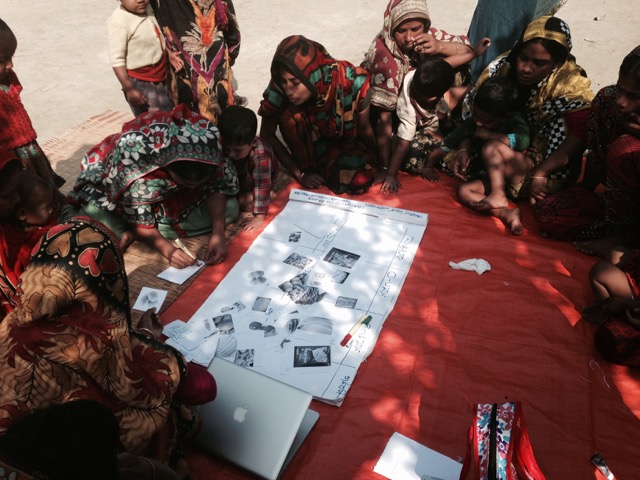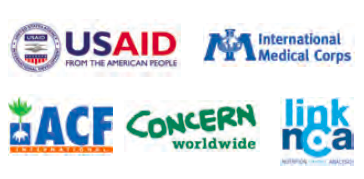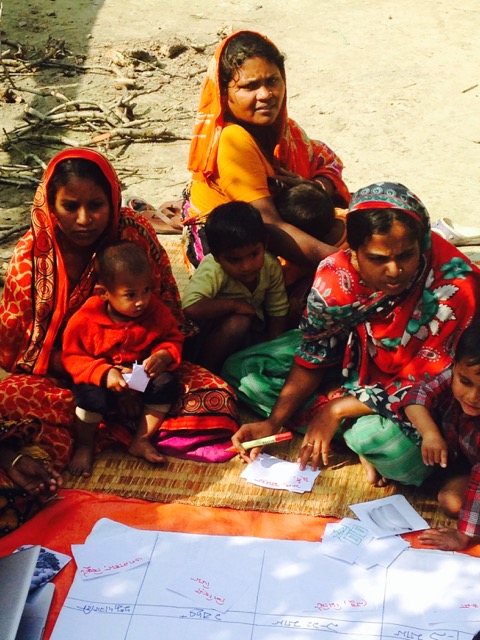Building a case for causality through the NCA approach in Satkhira, Bangladesh
 Marijka van Klinken, Matthew Parnaby, Paulina Acosta and Julien Chalimbaud
Marijka van Klinken, Matthew Parnaby, Paulina Acosta and Julien Chalimbaud

Marijka van Klinken was the NCA Analyst conducting this study. She holds an MSc of Public Health Nutrition from LSHTM. She coordinated a field research project for ENN and worked for FAO Somalia.

At the time of the study, Matthew Parnaby was the Nutrition Head of Department at ACF in Bangladesh. Matthew holds an MSc in Public Health and is an experienced Medical and Nutrition professional working with ACF, MSF, CDC (Northern Territory Australia), and ECHO.

Paulina Acosta is a regional advisor on Mental Health and Care Practices with ACF. She holds a master’s degree in intercultural psychology and she previously worked in various roles in mental health and psychosocial programmes in South Sudan, Darfur and Bangladesh with ACF; in Palestine, Central African Republic and Papua New Guinea with MSF and in Lebanon with Handicap International.

Julien Chalimbaud is the Link NCA project coordinator at ACF France for the past four years. He has 15 years of domestic and overseas experience in Food Security and Nutrition.
The authors extend that’s to the Satkhira District, Upazila and Union Authorities for their support and collaboration during the planning and implementation of the Nutrition Causal Analysis (NCA), as well as all stakeholders who participated in the NCA workshops. The Link NCA was funded by the European Commission’s Humanitarian Aid department.
Location: Bangladesh
What we know: The prevalence of child and maternal undernutrition is persistently high in Bangladesh and is multi-causal.
What this article adds: A structured method for conducting nutrition causal analysis (NCA) has been developed by ACF called the Link NCA. It identifies plausible causes of undernutrition in a local context to inform programming. In Bangladesh, seasonal factors (e.g. waterlogging), poor food quality and diversity, and maternal care were recognised risks by the community, however structural and societal factors (e.g. distrust in the health system, misinformation) negatively influence practice. Some perceived risk factors (side-effects of pesticides) are not addressed by any programmes. Involvement of local stakeholders and multi-sectoral representatives are key to the process.
Bangladesh, originally known as the “basket case” of Asia, has stunned all critics with the impressive gains on poverty reduction, reducing the national levels of poverty by one-third in the last decade1. In addition, it has shown the possibility of implementing widespread countrywide programmes, including birth control and basic education2. However, despite impressive reductions in maternal and child mortality, the prevalence of child and maternal undernutrition continues to remain persistently high, with recent figures as high as 41.4% stunting and 15.1% of wasting3.
ACF-International (ACF-INT) has worked in Bangladesh since the cyclone Sidr emergency response in 2007 and in Satkhira district since 2011 in response to the flooding emergency and resulting waterlogging. In the 18 most vulnerable unions of Satkhira district, ACF-INT has implemented a comprehensive nutrition programme, along with a psychosocial component aimed at increasing the effectiveness of the treatment, as well as assisting behaviour change and reinforcing positive child and maternal care practices. Due to the consistently high rates of undernutrition in Satkhira, ACF-INT started a detailed investigation into the socio-cultural and economic causes of undernutrition, using the recently developed Nutrition Causal Analysis (NCA) mixed methodology which triangulates quantitative and qualitative information, to identify plausible causes of undernutrition in a local context4 (see Box 1).
Box 1: Link NCA project
A nutrition causal analysis (NCA) is a method for analysing the multi-causality of undernutrition, as a starting point for improving the relevance and effectiveness of multi-sectoral nutrition security programming in a given context.
In order to strengthen the analytical foundation on which its programmes are built, Action Contre la Faim (Action Against Hunger) invested in the development of a structured method for conducting nutrition causal analysis called the Link NCA. To be actionable by operational stakeholders, the Link NCA needed to be Structured, Local (to be adapted to specific local communities) and Operationally feasible. ACF formed a multidisciplinary scientific committee5 of researchers and technical experts to propose such a method that was tested in Bangladesh, Zimbabwe (2011) and Burkina Faso (2013).
The Link NCA is a structured, participatory, holistic study, based on the UNICEF causal framework, intended to build evidence-based consensus around the plausible causes of undernutrition in a local context. The Link NCA links stakeholders across sectors; links risk factors and undernutrition to identifying pathways; links different sources of information to build evidence-based consensus around the plausible causes of under-nutrition and links the causal analysis to a programmatic response.
OFDA is currently funding a two years programme to scale up the use of the LINK NCA with two main components:
1) Implementing five Link NCAs in three priority countries in partnership with IMC, CONCERN, ACF USA and ACF France. The objective is to learn more lessons from these field experiences especially by supporting the operational response phase.
2) Building a technical unit to provide technical support and training to any organisation willing to conduct Link NCA studies. The objective is to promote the method through awareness centered on a dedicated Link NCA website. Any organisation implementing a Link NCA can receive the technical expertise and necessary training.
For more information, contact: Julien Chalimbaud at nca@actioncontrelafaim.org

The objective of the NCA is not to demonstrate statistically causal association or infer one main cause, but rather, to build up a case for multi-sectorial causality, based on different sources of information, using a clear structured approach of five steps:
- Designing the NCA using secondary data information to formulate draft hypotheses for the case of causality for undernutrition.
- Identifying hypotheses of risk factor of causality using the UNICEF conceptual framework as a basis, and creating a local hypothetical model together with stakeholders6.
- Gathering evidence of causality, through qualitative and quantitative methods, using a data collection plan. In this instance, qualitative data collection was done through Focus Group Discussions (FGDs), participant observation, transect walks and key informant interviews (KII) in each of the four selected villages7. A one-day interview with key informants of the village was conducted followed by three days of FGD’s related to Nutrition; Food Security; Health, water, sanitation and hygiene (WaSH); and Mental Health and Care Practices (MHCP). Case histories of malnourished and positive deviant cases of children were also conducted. Quantitative data collection was through two main surveys - a Food Security Livelihoods and WaSH in-depth survey conducted in October 2013, and an integrated SMART survey conducted in January 2014. Questions on the risk factors for undernutrition were included in the SMART household questionnaire.
- Analysis and triangulation of the information collected to formulate a comprehensive understanding of the immediate, underlying and basic risk factors for undernutrition.
- Building a consensus around the findings, through the participatory ranking of “relative importance” of the risk factors to undernutrition together with the stakeholders and communities.
The nutrition situation in Satkhira is currently classified as serious according to the WHO scale (global acute malnutrition (GAM) prevalence: 13.8%), with underweight and stunting prevalence remaining at very high and high levels (30% and 29%) respectively8. The perception of risk factors to undernutrition in the community related primarily to poor food quality and diversity, resulting from poor land access and cultivation due to the increased frequency of waterlogging (prolonged flooding). Poor maternal care, especially during pregnancy, also featured strongly in the communities’ perception of what causes undernutrition, with purposeful reduction of food intake in the 3rd trimester noted as a reason for low birth weight and underweight children.
Only 44.4% of children aged 6-23 months consumed an acceptably diverse diet (>4 food groups) and 66.7% children aged 6-59 months reported an illness in the preceding two weeks, reflecting a worrying dietary intake and disease prevalence. Detailed analysis found that co-morbidities had a significant negative effect on wasting and underweight indicators.
Through qualitative, quantitative and secondary level enquiry, along with the validation of a wide range of experts, a number of risk factors for malnutrition were identified. Figure 1 demonstrates an excerpt of the local conceptual model drawn, highlighting the major and important risk factors only9.

From the qualitative component, it was interesting to note that some of the risk factors were well understood by the communities, but social, cultural or economic constraints prevented positive behaviours from being practiced. Societal and cultural influence had a marked impacted on maternal care practices, and any programmes tackling behavioural change in this field would need to take this into account. For example, early marriages, and the ensuing early age of pregnancies, was highlighted by all as being a major risk factor by both the communities and quantitative findings. The average age of first pregnancy was given as 18 years, with 16 being the average age of first marriage. However, results from the qualitative work indicate an earlier age, suggesting potential bias in the responses given in the quantitative feedback. While all members of society noted that early pregnancies would likely have a negative impact on child and maternal care, societal pressures kept this practice alive.
Other risk factors were found to emanate from misconceptions, arising from fears that have been propagated by stories within the community. These misconceptions perpetuated behaviours that were a major risk factor to undernutrition. Behaviour such as decreasing food intake, especially in the final trimester, which were initially hypothesised to derive from a desire to decrease the size of child at birth were also discovered to arise from a fear of caesarean sections. In the quantitative component, 54.6% of women were found to decrease food intake during pregnancy. Health advice during pregnancy was regularly sought from traditional birth attendants, who advised decreased food intake, especially during the 3rd trimester. The preference of home births, alongside a distrust of the public health care system, and the prohibitive costs of private health care (doctors tend to prescribe caesarean sections too often in order to generate higher incomes), further drive women to decrease food intake in their last trimester.
While the Bangladesh government has invested a lot of effort on the health structure, the entrenched mistrust in community health structures, with allegations of corruption and inappropriate services, remains a worry. This was noted as being an important risk factor, fuelling inappropriate health seeking behaviour resulting in access to inappropriate messages, especially for child and maternal care.
Seasonal impacts such as waterlogging played a pervasive role in the perception of risk factors for undernutrition in the communities. The impact of waterlogging permeated all spheres in the community, affecting income and food security indicators, rendering water and sanitation facilities inaccessible, increasing time spent on household tasks and leading to deteriorating care practices in the community.
The community believes that some risk factors are not being addressed through any programmes. For example, a major worry for the health of the community is that the increased use of pesticides, chemical fertilisers and formalin, which are recognised as being instrumental in increasing production, are detrimental to the quality of the food produced. This should not be overlooked and may sustain negative practices.
Programme orientation recommendations
From the NCA, it was concluded that structural as well as societal changes needs to occur in the ACF-INT working areas in order for there to be a holistic approach to tackling undernutrition. Conversations with the community have highlighted the multi-faceted causes of undernutrition in the area and several community recommendations will require a concerted effort on the part of the government to tackle structural changes. For ACF-INT programmes, the NCA findings demonstrate the need for a more integrated approach to project planning and implementation. Some highlighted recommendations that arose from the NCA were as follows:
- Strengthen MHCP programmes to work with communities in Satkhira to identify positive practices to reinforce and facilitate behaviour change at the household level and increase awareness of child and maternal care practices. Complementary feeding before 6 months of age is a strong practice in Satkhira and in Bangladesh in general. Specific programming to reinforce practical understanding about appropriate timing of transition from exclusive breastfeeding to complementary breastfeeding is necessary and should include infants aged 3 to 6 months in the target group.
- Strengthen nutrition sensitive programming being delivered through community clinics, including pre- and post-natal check-ups and maternal nutrition advice.
- Improve health access behaviour of pregnant women, increasing their knowledge on appropriate supplementation during pregnancy and tackling the barriers they face.
- Increase the knowledge of traditional birth attendants to reinforce appropriate maternal nutrition advice, to reduce low birth weight and limit adverse misconceptions surrounding maternal nutrition, health and childbirth.
- Strengthen access to quality water and sanitation facilities, including community education campaigns to highlight hygiene behavioural practices.
Limitations and lessons learned
 There are limitations to the NCA approach. Firstly, in order to triangulate the data, information is collected from a variety of sources, each with its own inherent bias. Risk factors highlighted do not always conform to clear cut-offs and guidelines by the public health community, especially those on the basic level of the UNICEF conceptual framework. These are also the hardest to test quantitatively, resulting in a reliance on qualitative sources. These difficulties also extended to scientific evidence, where some causal associations were clearly underpinned by robust studies whereas others were not. This led to some difficulty confirming the hypotheses for certain risk factors.
There are limitations to the NCA approach. Firstly, in order to triangulate the data, information is collected from a variety of sources, each with its own inherent bias. Risk factors highlighted do not always conform to clear cut-offs and guidelines by the public health community, especially those on the basic level of the UNICEF conceptual framework. These are also the hardest to test quantitatively, resulting in a reliance on qualitative sources. These difficulties also extended to scientific evidence, where some causal associations were clearly underpinned by robust studies whereas others were not. This led to some difficulty confirming the hypotheses for certain risk factors.
At the community level, understanding of the links between food intake and malnutrition were clear whereas there was less clarity around care practices. This required additional time, which was not always available, to explore some of these causes.
While efforts were made to include a wide group of technical experts, due to various time constraints and levels of insecurity, it was not possible to get representatives from each sector at the initial technical workshop. To ensure the development of local and context specific hypothesis during initial workshops, great efforts were made to have local level experts and key stakeholders present.
For more information, please contact: Paulina Acosta, email: pacosta@actioncontrelafaim.org
1 Jolliffe Dean, Sharif Iffath, Gimenez Lea, Ahmed Faizuddin, 2013. Bangladesh - Poverty assessment: assessing a decade of progress in reducing poverty, 2000-2010. Bangladesh development series; paper no. 31. Washington DC; World Bank.
2 Bangladesh: Innovation for Universal Health Coverage. The Lancet Global Health Series, vol. 382, no. 9906, Nov. 2013
3 National Institute of Population Research and Training (NIPORT), Mitra and Associates, and ICF International. Bangladesh Demographic and Health Survey 2011. Dhaka, Bangladesh and Calverton, Maryland, 2013.
4 Guidelines for conducting a Nutrition Causal Analysis. ACF, 2014. Under publication.
5 The group was composed of Dr. J.Coates, Dr H Young, Sr Y Martin-Prevel, S Jaspers, K Ogden, and a group of senior technical experts from ACF.
6 A wide-range of experts was gathered from local and international NGO’s, as well as UN agencies. These were: UNICEF, FAO, WFP, Save the Children, PCI, Solidarite International, Hellen Keller International, World Vision, TMSS, Uttaran, Shushilan and ACF-INT. Government representatives were invited but were unfortunately unable to attend.
7 A random selection of four villages was drawn from the 30 randomly sampled SMART clusters.
8 SMART Survey January 2014 in ACF working areas of Satkhira district, ACF-International, 2014.
9 For a full diagram, refer to the full NCA Satkhira report, ACF, 2014

